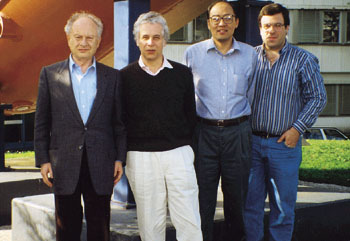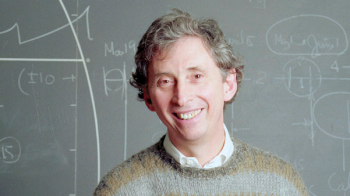Pomeranchuk prize

The prestigious Pomeranchuk prize, which is administered by Moscow’s Institute for Theoretical and Experimental Physics (ITEP), is awarded this year to Karen Avetovich Ter-Martirosyan (ITEP, Moscow) and Gabriele Veneziano (CERN).
Prof. Ter-Martirosyan receives the prize for his pivotal contribution to quantum mechanics and quantum field theory. Born in 1922, he was a pupil of L D Landau and a close collaborator of I Ya Pomeranchuk. Among Ter-Martirosyan’s students have been V N Gribov, A A Anselm, A M Polyakov, A A Migdal, A B Zamolodchikov and A B Kaidalov. He is an author of more than 250 articles and the book Theory of Gauge Interactions of Elementary Particles (1984) with M B Voloshin. His papers include “Theory of coulomb exitation of nuclei” (1952), “Theory of three body systems” (1956), “Development of the Regge pole theory for high energy scattering and theory of Regge cuts” (with V N Gribov and I Ya Pomeranchuk (1964-1976), and “QCD inspired model of quarkgluon strings” (with A B Kaidalov).
The prize is awarded to Gabriele Veneziano for his outstanding contributions to quantum field theory and the theory of strings. Born in 1942, he has been a staff member at CERN since 1977. His famous 1968 construction of a hadron amplitude satisfying the requirements of crossing symmetry and analyticity triggered the development of dual theory of strong interactions and string theory. His 1974 elaboration of large N expansion in dual models and QCD remains a cornerstone in strong interaction theory. His major contributions also include “Jet calculus in QCD”, “Analysis of symmetry violation in QCD and its phenomenological consequences”, “the Di Vecchia-Veneziano and Veneziano-Witten relations”, “Construction of the effective supersymmetric action and formulation of the nonperturbative aspects of SUSY theory”, and latterly “String cosmology”.
Nominations for next year’s Pomeranchuk prize should be send to pomeron@heron.itep.ru no later than 1 February 2000.
New chairmen appointed to DESY committees
Ministerialdirigent (assistant secretary) Hermann Schunck from the Federal Ministry for Education and Research (BMBF) becomes the new head of DESY Administrative Council. He replaces MinDirig Hans C.
Eschelbacher has been the head of the council for five years and is now president of CERN Council.
Ralph Eichler from Villingen becomes the new head of the Scientific Council, replacing Dietrich Wegener, who has been in office for three years.
Thies Behnke becomes the new head of the Scientific Committee, replacing Wilhelm Bialowons, who has held the position for a year.
LETTERS
CERN Courier welcomes feedback but reserves the right to edit letters. Please e-mail “cern.courier@cern.ch“.
Free electron lasers
With reference to the CERN Courier article entitled “Expo 2000”, which was published in the May issue, I should like to mention two points.
The self-amplified, spontaneous emission, free electron laser (SASE-FEL) concept originated in the early 1980s (Derbenev et al., 1982; Bonifacio et al. 1984). The first detailed proposal and study to use this concept for an X-ray FEL goes back to 1985 (Murphy and Pellegrini 1985).
During the past two years, several groups at UCLA, SLAC/SSRL, Brookhaven and Los Alamos have performed experiments proving this concept (Hogan et al. 1998; Babzien et al. 1998; Nguyen et al. 1998).
The most comprehensive experiment has been carried out by a UCLALos AlamosSSRL group that has measured the FEL photon statistics and a gain of 3 x 105 over the spontaneous undulator radiation (Hogan et al. 1998). Both sets of experimental results are in excellent agreement with the theoretical predictions.
These results, and the strong interest in the unique properties of the radiation generated by an X-ray SASE-FEL, are the foundation for the Linac Coherent Light Source project at SLAC (LCLS Design Study Report 1998). The Basic Energy Science Division of the US Department of Energy recently endorsed a research and development programme of the LCLS for the period 1999-2002, with a view to start construction in the financial year 2003.
Claudio Pellegrini, Department of Physics, UCLA
Further reading
Y Derbenev, A Kondratenko and E Saldin 1982 Nucl. Instr. and Meth. Phys. Res. A193 415.
R Bonifacio, C Pellegrini and L Narducci 1984 Opt. Comm. 50 373.
J Murphy and C Pellegrini 1985 Nucl. Instr. and Meth. Phys. Res. A237 159.
J Murphy and C Pellegrini 1985 J. Opt. Soc. America B2 259.
M Hogan et al. 1998 Phys. Rev. Lett. 80 292.
M Babzien et al. 1998 Phys. Rev. E57 6093.
D Nguyen et al. 1998 Phys. Rev. Lett. 81 810.
M Hogan et al. 1998 Phys. Rev. Lett. 81 4867.
1998 LCLS Design Study Report SLAC-R-521.
DESY replies:
We thank you for informing us of the UCLA, SLAC/SSRL, Brookhaven SLAC and Los Alamos achievements concerning the
SASE-FEL, which we did not intend to underestimate in any way.
The “EXPO 2000” article in the May issue of CERN Courier was meant to be a presentation of DESY’s next major public relations project, the EXPO 2000 exhibition, entitled “Light for the New Millennium”, to a broad audience. This was a very welcome opportunity provided for us by CERN Courier. It was not intended as a scientific publication and we thought that this would be obvious from both its style and content.
Indeed, we consider that the task of introducing the public to the fascination of science is of major importance, and it is not always easy in such an article to give credit to all relevant research work. That is why the SASE-FEL principle was mentioned only rather briefly, and in a way that could indeed have been interpreted as if it were solely a DESY development. This was not our intention, however, and we apologize if it has been construed in such a way.
This year’s goal at DESY is the proof-of-principle of a SASE-FEL at a wavelength of less than 100 nm more than two orders of magnitude in wavelength less than the result published by the UCLA/Los Alamos/SSRL group last year. The FEL pilot facility, on display at EXPO 2000, is under construction at DESY.
From 2003 it will deliver radiation at a wavelength of 6 nm for the international user community, which will make it the first SASE-FEL facility to go into research operation.
Petra Folkerts, Project Leader DESY-EXPO.
MEETINGS
An international summer school entitled Experimental Physics Of Gravitational Waves will be held in Urbino, Italy, on 618 September. Supported by the Institute of Physics, Urbino University and INFN Florence Section, it is aimed at graduate and postdoctoral students.
The annual DESY Theory Workshop, to be held this year on 29 September 1 October, has the theme *ews from the Universe and will cover neutrino masses and oscillations, baryon and lepton number violation, the cosmological constant, and the structure in the universe. The speakers will include many distinguished names from all over the world.
Parallel sessions are mainly reserved for young researchers. Contributions should be sent before 1 August, together with registration. Limited financial support for young physicists is possible.
Registration via Mrs S Günther, DESY-Theorie, Postfach, D-22603 Hamburg, Germany, fax +49 40 8998 2777.
Information is available from C Wetterich, Institut für Theoretische Physik, Universität Heidelberg, Philosophenweg 16, D-69120 Heidelberg, Germany or “http://www.desy.de/desy-th/workshop.99/“.
XI ISVHECRI, the XI International Symposium of Very High Energy Cosmic Ray Interactions, will be held in Campinas in Brazil on 17-21 July 2000. It will celebrate the centennial of Gleb Wataghin.








